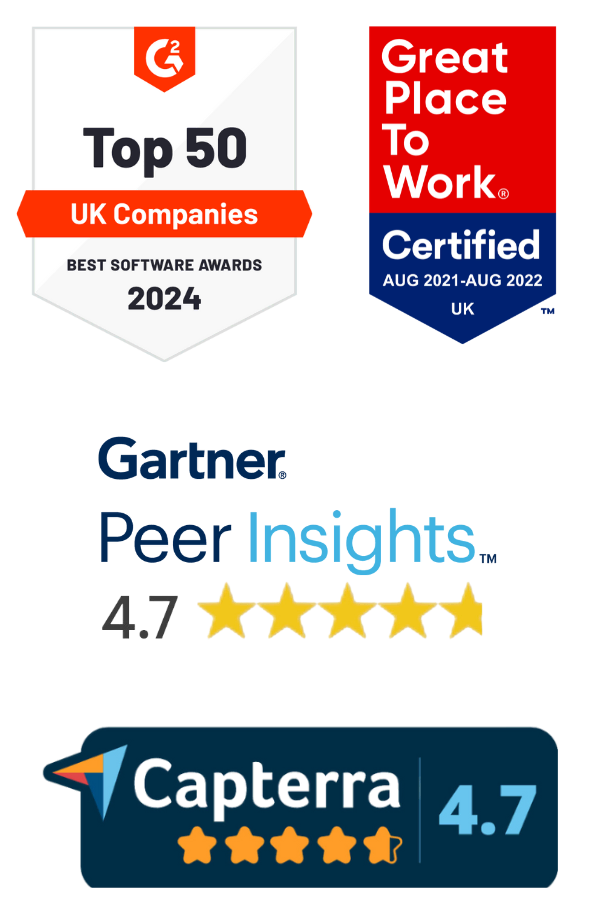
Employee advocacy has come a long way from the days of “please share this post.”
The World’s Biggest Employee Advocacy Study analyzed over 500,000 employee LinkedIn posts to uncover what really drives impact, and the results are clear: authenticity wins.
Posts written in an employee’s own words generate 9× more engagement than company-curated content, while even small caption edits can triple results.
But what does that look like in practice?
To find out, we turned to eleven industry leaders, from CMOs and marketing strategists to employer branding experts, who each shared their take on these findings.
Together, their insights paint a picture of an industry evolving fast: from amplification to authenticity, from top-down messaging to trust built from the inside out.
Authenticity Builds Trust
The data confirms what advocacy leaders have long known: audiences trust people more than brands.
Authenticity on social media is more than a trend.
When employees share stories in their own voice, they amplify reach, but also make brand messaging believable.
Anna Bertoldini summed it up perfectly:
Employee advocacy has evolved from a nice-to-have into one of the most powerful brand-building tools we have.
When people inside the company share stories in their own voice, they don’t just amplify reach, they build trust, attract talent, and turn brand messaging into something audiences actually believe.
What stands out most in this report is how clearly the data backs up what I see in practice: employee advocacy isn’t just a distribution channel anymore, it’s a driver of visibility, credibility, and long-term trust.

Anna Bertoldini, Global Brand Marketing Manager at NielsenIQ.
🎥 Watch Anna’s episode of the podcast for practical insights on building your personal brand as an employee, and the long-term career benefits of doing so.
For Roy Sexton, this authenticity comes down to empathy and intention:
Authenticity is one of those words that gets thrown around a lot these days, often by people who don’t exemplify it.
But what this report shows us is that people who engage on these platforms from a genuine place of empathy and intellectual curiosity make a huge difference in brand building.
Organizations would be wise to embrace these techniques and tools to leverage genuine voices across their communities.

Roy Sexton, Chief Marketing Officer at Vedder Price.
🎥 Check out Roy’s episode of the podcast for insights on how to scale employee advocacy in one of the most regulated industries: the legal sector.
Chris Sheen reminds us that sounding human isn’t optional for employee advocacy success:
Employee advocacy only works when it stops sounding like employee advocacy. It has to sound human.
People don’t engage with brands, they engage with people.
Authenticity isn’t optional anymore, it’s the algorithm.

Chris Sheen, Director of Social at Celonis.
🎥 Chris’s episode of the podcast reveals strategies for engaging over a thousand employee advocates and how to use AI without losing the human element of your content.
Curious how your employee advocacy efforts stack up?
DSMN8’s free Competitor Analysis Review shows how active your team is on LinkedIn, and how that compares with others in your industry.
Small Edits, Big Impact
One of the report’s most surprising insights?
Posts with even minor caption edits achieve 3× more engagement than unedited ones. Personal touches matter.
These experts explain how empowering employees to make content their own transforms results.
That “small edit” effect is something Sarah Ruzgar O’Connell has seen first-hand:
I love how this report quantifies and provides actual data on employee advocacy – it’s much needed in this space. None of these results really surprised me as they mostly echo what I saw on the Awin program.
The ‘small edits – big results’ insight (Posts with even minor caption edits achieve 3x more engagement than unedited posts), echoes exactly the point I made in my podcast episode and what you surmised in the report: authenticity drives the biggest impact.
This will become even more apparent with the increasing amount of AI-created content, which is filling our feeds. I’m all for AI assistance, but it is always obvious when you haven’t taken the time to shape in your own voice and with your own perspectives.

Sarah Ruzgar O’Connell, Executive & Employee Communications Lead at Heineken.
🎥 In Sarah’s episode of the podcast, she highlights the importance of personal branding in the new era of employee advocacy and the key role that company culture plays in long-term program engagement.
Maike Jansen believes that equipping employees with the skills to customize their content is worth advocating for:
I was glad to see the report highlight the power of personal, authentic employee advocacy. I’ve always advocated for customizing posts when speaking to ambassadors, knowing it makes posts more impactful.
Still, I didn’t expect that even minor tweaks could lead to such a big effect: three times more engagement! It shows how vital it is to equip employees with the skills to personalize provided content themselves.

Maike Jansen, Employee Advocacy Lead at dentsu Benelux.
🎥 Maike’s podcast episode is all about managing brand safety and security while encouraging employee-generated content. A must-watch for those in regulated industries.
Lyuba Meystelplatz emphasizes that employee advocacy is all about empowering employees to share their own voice, not to sound like marketers:
Employee advocacy isn’t about teaching people to sound like marketing, it’s about helping them sound like themselves, with purpose.
DSMN8’s data reinforces what I’ve been saying for years: authenticity wins. A personal reflection can turn an employee post from content into conversation.
Real impact doesn’t come from how many people share, but from how real those shares feel.

Lyuba Meystelplatz, Senior Social Media Strategy Manager at IDeaS Revenue Solutions.
🎥 Lyuba’s podcast episode covers her experience starting an employee advocacy program using spreadsheets back in 2012, and the journey to now managing a multilingual program that drives real business impact. A must-watch for those wanting to understand the key metrics executives want to see.
Sam Moles shares that he’ll be applying these insights to the advocacy program he runs at a law firm:
Very interesting findings, the data around the most effective types of posts is illuminating.
I will be taking what you’ve unveiled to inform my advocacy program at Stephens Scown – particularly how tweaks to some behaviors we’ve trained can substantially enhance reach and engagement.

Sam Moles, Digital & Personal Brand Specialist and Employee Ownership Advisor at Stephens Scown.
🎥 Sam’s episode of the podcast is all about best practices for making advocacy part of company culture at a law firm, from building confidence to providing training to get senior lawyers on board.
The takeaway? Empower employees to edit, adapt, and personalize the content they share.
A small tweak can be the difference between a scroll and a conversation.
The Rise of Employee Influence
Employee advocacy is no longer just a distribution tactic; it’s a driver of visibility, credibility, and growth.
Employees are becoming influential voices, shaping brand reputation far beyond company channels.
For Andy Lambert, this shift reflects a broader transformation in how trust scales online:
That 9× engagement lift when employees post in their own voice is proof of a deeper shift that’s happening right now. Trust flows through people, and when employees share content in their own words, it resonates more deeply than corporate content because it feels real. It’s what I call personality-driven growth: scaling trust from the inside out.
In my latest book, Spheres of Influence, I describe how the most forward-thinking B2B brands, from PwC to Cisco, are moving beyond “employee advocacy” to empowering subject-matter experts to build their own platforms. These individuals aren’t just amplifying brand content; they’re becoming trusted voices in their own right. And that’s why engagement jumps ninefold.
People trust people, not logos. The future of brand reach will be built on the credibility of these individuals.

Andy Lambert, Principle Product Manager at Adobe.
🎥 In Andy’s podcast episode, he reveals his vision for ‘Social 3.0’: a more human, decentralized, and trust-led approach for social media and the advantages this brings for brands.
Alex Her adds that too many brands still underestimate just how much power sits inside their own teams:
The average engagement from an employee post is powerful and very telling.
So many brands pigeonhole themselves into only believing that their brand pages deliver more impact and reach, when it could be further from the truth.
More proof that people listen to people.
🎥 Alex’s episode of the podcast is all about starting an employee advocacy program from scratch, covering gamification, the importance of company culture, plus practical ways to leverage AI to scale production without losing authenticity.
Ready to empower your employees to share authentic, high-impact content?
Discover how DSMN8 helps you launch, scale, and measure advocacy programs that drive ROI.
Mastering LinkedIn
With 98% of employee advocacy happening on LinkedIn, nailing your strategy matters more than ever.
Understanding how to use the platform with intentionality is the key to success.
The study’s data shows that employees with networks of 5,000–10,000 connections can drive higher engagement than high-follower accounts. It’s not always about leveraging your biggest influencers!
For Jordan Tennenbaum, the report’s findings echoed what he knew from experience: any employee can drive ROI on social media.
It’s almost like the things social media professionals have been preaching were correct all along.
Social media is such an important tool in the toolbelt of ALL employees because with very little time and effort, anyone can produce massive ROI.

Jordan Tennenbaum, Head of Social Media at Talkdesk.
🎥 Jordan’s episode of the podcast is a masterclass in maximizing LinkedIn engagement by building a community of engaged advocates and thought leadership.
Barney O’Kelly highlights that the impact LinkedIn has isn’t just in marketing; it supports business developent and talent attraction too:
LinkedIn has its critics, and often deservedly so, but done well with real intention and good habits it can make a significant impact on the brand of both the organisation and the individual and lead to some powerful outcomes in terms of network building, business development and talent acquisition.

Barney O’Kelly, Head of Solutions and Product Marketing at AlixPartners.
🎥 In Barney’s podcast episode, he explains the difference between influence and amplification, highlighting the role of human connection over measuring metrics. He shares invaluable perspectives on how employees can overcome the fear of posting and start investing in their personal brands.
Final Thoughts & Additional Resources
The numbers prove it. The experts agree.
Authenticity on social media isn’t optional anymore.
The future of brand reach will be built on the credibility of those inside the company who choose to share their voice.
📊 Download The World’s Biggest Employee Advocacy Study to see all the benchmarks and more insights behind these findings.
Ready to launch an employee advocacy program that drives ROI?
More resources for starting your employee advocacy program:
- Get a free Competitor Analysis Review to find out how active your team is vs. your competitors.
- Request a copy of Employee Advocacy: 101 Cheat Codes by DSMN8 CEO Bradley Keenan for expert tips.
- Download the User Adoption Playbook for a step-by-step strategy to make advocacy part of your culture.
Emily Neal
SEO and Content Specialist at DSMN8. Emily has 10 years experience blogging, and is a pro at Pinterest Marketing, reaching 1 million monthly views. She’s all about empowering employees to grow their personal brands and become influencers.




